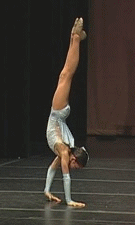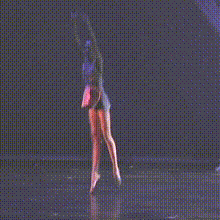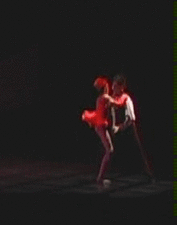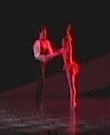Acro dance
This article needs additional citations for verification. (May 2024) |

Acro dance is a style of
Acro is an especially challenging
History

Acrobatic dance emerged in the United States and Canada in the early 1900s, as one of the types of acts performed in vaudeville. Although individual dance and acrobatic acts had been performed in vaudeville for several decades prior to 1900, it was not until the early 1900s that it became popular to perform acts that combined dance and acrobatic movements.[2]
Acrobatic dance did not suddenly appear in vaudeville; rather, it appeared gradually over time in a variety of forms, and consequently no individual performer has been cited as its originator. Sherman Coates (1872–1912),[3] who performed with the Watermelon Trust from 1900 to 1914, was recalled by fellow dancers as the first acrobatic dancer they had ever seen.[4] Another of the earliest documented acrobatic dance performers was Tommy Woods, who became well known for his slow-motion acrobatic dance in Shuffle Along, in which he would execute acrobatic movements precisely in time with the music.[5] In 1914, acrobat Lulu Coates formed the Crackerjacks, a popular vaudeville troupe that included acrobatic dance in their performance repertoire up until the group disbanded in 1952.[6] Many other popular vaudeville companies combined acrobatics and dance in their shows, including the Gaines Brothers.
Since the decline of the vaudeville era, acrobatic dance has undergone a multi-faceted evolution to arrive at its present-day form. The most significant aspect of this evolution is the integration of ballet technique as the foundation for dance movements, thus bringing into acro dance a precision of form and movement that was absent in vaudeville acrobatic dance. Also, vaudeville acrobatic dances were often little more than acrobatics set to music, whereas modern acro dance is fundamentally dance, with its acrobatic movements performed in a dance context.
Characteristics
A defining characteristic of acro is the smooth, graceful transitions between dance and acrobatic movements. Also, a dance must have a significant percentage of dance movement, with respect to its acrobatic content, in order for it to be categorized as acro. For example, a gymnastics floor exercise is not considered to be acro because it has little or no dance movement compared to its acrobatic content, and also because it lacks smooth transitions between dance and gymnastic movements. Also, acro does not employ supporting apparatus such as those used in acrobatic gymnastics.[7]
Dance technique
The dance movements in acro are founded in
Acrobatic elements
The acrobatic movements and acts of balance performed in an acro dance are referred to as tricks. A variety of tricks are commonly performed in acro dance, varying widely in complexity and the skills required to perform them. Aside from the obvious requirement that dancers possess the requisite skills to perform tricks, the types of tricks that can be performed in an acro dance depends on the number of dancers. Solo tricks can be performed by independent dancers in
|
|
Double tricks—also known as partnering tricks—can only be performed by a pair of dancers. An example of this is the pitch tuck, in which one dancer forms a "saddle" with his hands. The second dancer steps onto the saddle and then the first dancer thrusts the saddle upward. The second dancer, who is propelled upward with back rotation, lands on her feet after a complete revolution in the air. Acro partners will sometimes execute lifts and
|
|
Group tricks generally require three or more dancers. Examples of this are:
- Bridge pyramid
- Triple cartwheel
Apparel
Footwear
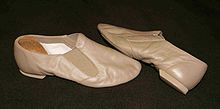

Acro dances are typically performed on hard stages with widely varying surfaces. Such floors differ substantially from a
All of the most common types of acro footwear provide both traction and cushioning. In addition, acro performance surfaces are frequently rough, so acro footwear must protect the bottom of the foot from skin abrasion.
Acro shoes
Acro dancers most often wear
Foot thongs
Less commonly, acro dancers may wear foot thongs, which are variously called Dance Paws and FootUndeez, depending on the manufacturer. Foot thongs—which are slip-on, partial foot covers that protect only the ball of the foot—are sometimes preferred over acro shoes for aesthetic reasons. In particular, flesh colored foot thongs endow the wearer with the appearance of having bare feet, while retaining some degree of the traction, cushioning, and abrasion protection provided by acro shoes.
Clothing
Acro dancers commonly wear flexible, form-fitting clothing for both
Competitive acro dancers frequently wear
Competitive acro
Acro dance is not uniformly defined within the competitive dance industry.[1] Some dance competition companies require an acro routine to have a minimum of four or five tricks with at most fifty percent acrobatic content. Other companies require an acro routine to have exactly, or more than, fifty percent acrobatic content. Also, at some competitions an acro dance may fit into an explicitly defined "acro dance" performance category, while at others it may fall into a similar category such as "acro/gym," or an alternative category such as "open." Because of these differences, it may be necessary to enter a specific acro routine into different performance categories at different competitions.
See also
References
- ^ a b Jim Lamberson. "Acro Dance as defined by the Competitive Dance Industry". Archived from the original on 2008-05-03. Retrieved 2008-04-03.
- ^ "Acro Dance - A Rhythmic Amalgamation of Acrobatics and Dance". DancePoise. Retrieved 2017-10-02.
- New York Age, May 30, 1912, pg. 6, col. 3
- ISBN 0-415-93853-8.
- ISBN 0-306-80553-7.
- ^ StreetSwing Dance History Archives. "The Crackerjacks". Archived from the original on 4 July 2008. Retrieved 2008-06-06.
- ^ Harris, Cora (2022-06-09). "Acro Dance: An Amazing Fusion of Acrobatics and Dance". City Dance Studios. Retrieved 2022-06-26.
- ^ Carla Webber. "Acrobatic skills for acro dance". Archived from the original on 3 May 2008. Retrieved 3 April 2008.


